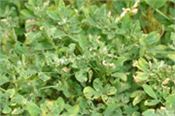Control Considerations For Alfalfa Weevils – Odds And Ends
DR. LEE TOWNSEND
LEXINGTON, KY.
This seems to be a banner year for the alfalfa weevil, at least in some regions of the state. Here are some things to consider for effective weevil control:
1) There is no indication that insecticide resistance should be an issue in the Kentucky alfalfa weevil population. With one generation per year and a generally effective biological control established over the state, there have not been frequent, widespread insecticide applications. Registered insecticides should be effective.
2) A few adult weevils were present in sweep net samples taken on March 17, suggesting that at least a few more eggs are being laid. This will extend egg hatch, so there will be new larvae to challenge treatment res-idues. In addition, new plant growth is not protected by a previous application.
3) Temperature considerations – Pyrethroid insecticides (cyfluthrin, cyhalothrin, cypermethrin, permethrin) tend to be more active at lower temperatures than organophosphates. There is a cooling trend in the short-term forecast for Kentucky; this would favor pyrethroids over other insecticide groups.
4) Spray volume – Labels of several products recommend a minimum of 10 gallons per acre of finished spray for ground applications. Most also have a statement, such as this: Higher volumes of finished spray may improve insect control when foliage is dense and/or insect pressure is high. Failure to use sufficient volume could compromise control due to limited coverage.
5) Freeze-nipped alfalfa suffered a setback to the weevil. Treatment guidelines are based on stem length and numbers of weevil grubs. Freeze damage may have shifted the balance while not harming the insects.
6) Watch weather forecasts closely for rain and wind speeds that could lead to spray drift. ∆
DR. LEE TOWNSEND: Extension Entomologist, University of Kentucky

Figure 1. Alfalfa weevil damage.
Photo: Lee Townsend, UK